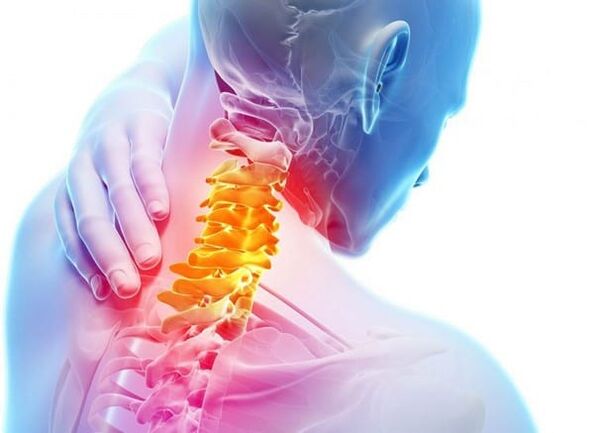
Symptoms of cervical osteochondosis may appear at any age, but risk increases after 25 years.Treatment earlier, the more likely it is to stop the disease in the egg and avoid unpleasant complications.
Symptoms of cervical column osteochondrosis
The signs of the cervical column at the initial stage of the disease can be lubricated, manifested episodically and not immediately alert the patient.
Osteochondrosis-Anching more than the deformation of the vertebrae of a spine associated with degenerative processes (destructive) which rejoice there.
The reasons can be different:
- Constant physical overload, unequal stretch of muscles, long stay in a static position (sitting on the computer, leading a car);
- Neck injuries;
- Incorrect nutrition with a predominance of fatty, salted and high food;
- Alcohol abuse and cigarettes;
- Metabolic and endocrine disorders.
At risk, people who overwhelmed heredity, overweight and patients with rheumatism.Synthesis, severe stress, can cause exacerbation of cervical osteochondosis.
Under the influence of external or internal factors in the spine, the pathological processes associated with a change in shape and position of the vertebrae, the refinement of cartilage and the formation of bone growths begin.
All this leads to tinks of blood vessels and nerve endings.Brain nutrition is disturbed, pain and discomfort appear.
Symptoms of cervical osteochondrosis include:
- Headache and dizziness;
- Weakness, prefabricated condition, fainting;
- A feeling of general discomfort, weakness, constant fatigue;
- Pain in the neck, the neck, the shoulder belt, the crisis by turning your head.
At the same time, visual acuity can decrease, hear aggravating, patients complain of noise in their ears and "flies" before their eyes.The symptoms described are the result of innervation disorders.
A long-term violation of blood supply to the brain causes migraines, vegetative-vascular disorders, respiratory pathologies and a cardiovascular system.
The vertebrae in the cervical region are strongly mobility with a small size, and the neck muscles are relatively low.The cervical column is affected negatively by static and high physical activity.
Degree of illness
There are 4 degrees of cervical osteochondosis.Each of them corresponds to its own symptoms, but in some cases, a specialist cannot simply make a precise diagnosis.
- The deformation of the spine is in its infancy, in the cartilaginous and bone tissue that the changes are almost not perceptible, the emerging symptoms are episodic.Patients associate pain and discomfort with overwork, stress, physical effort;
- The shape and height of the intervertebral disc change, its integrity can be raped.At this stage, the pain in the neck, the shoulder belt becomes constant.He can become numb, his head hurts.
- The intervertebral hernias, tightening the nerves and blood vessels, cause severe headaches, weakness, dizziness, pre -faubriques and fainting.The patient feels fatigue, pain on the back of the head, noise in the ears.
- The vertebrae is distorted, bone growth appear on them - the osteophytes have pinched the nerves.The vertebrae of neighboring departments suffer, the usual movements are disturbed, their amplitude is reduced, each movement is accompanied by intense pain in the neck, shoulder and collarbone.

Treatment of cervical osteochondosis
In men, cervical osteochondosis is less common than in women, it begins later, but the symptoms are more pronounced and the disease develops more quickly.During the first signs of home disease, it is necessary to start an affordable treatment:
- Daily neck gymnastics includes simple exercises that develop the spine and muscle apparatus that improve blood circulation (circular neck rotation, tilting to the shoulders, tilting back and forth);
- Alcohol and oil compresses, salt heating pads (cannot be used in the acute phase) will help relieve pain in the neck;
- Relieving the symptoms of cervical osteochondosis will help the use of drugs - spasmiers, analgesic, anti -inflammatory drugs.
During the first signs of degenerative processes of deformation in the cervical region, you should request a doctor.As a rule, conservative treatment is prescribed:
- physiotherapy;
- Massage (necessarily - professional!);
- Take medication that not only relieve symptoms of the disease, but also contributing to the restoration of cartilage - chondroprotective fabric in tablets or injections.
Cervical osteochondosis is easier to warn than to heal.
Among the preventive measures are the rejection of harmful salty and acute foods, respect for the work and rest regime, balanced physical activity.














































